The Role of Network Security in Class Conference During COVID-19 Pandemic
DOI:
https://doi.org/10.21512/emacsjournal.v4i3.8634Keywords:
Network Security, Conference Class, Cyber Attack COVID-19, Zoom BombingAbstract
Security is crucial for the network. But there are still system leaks, especially in class conferences during the pandemic. Because of a lot of data exchange and data entry, some viruses are difficult to identify. So, the role of network security is vital. Many viruses spread through links, and others can access cases of misuse of links; the issue is called Zoom bombing. So, from managing the instability of data in and out of conference classes during this pandemic, many activities are carried out online that awareness of more comprehensive network security. With the COVID-19 pandemic, class conferences are prevalent in today’s world. Millions of people use it for various reasons, and one of them is for education. However, there are issues related to the network’s security where users’ data was stolen and impersonated or network trafficking, which will cause fault and disruption in the network. This research have 3 methodologies include Systematic Literature Review, Research Questions (identify the focus of the literature review, which helps process the data more clearly), Result Finding (the study of an existing paper with specific keywords to answer the research questions). As the result, it can be concluded that there are many ways to prevent attacks by improving the network’s security such as network security defense mechanisms and firewall. So that everything can be petrified in terms of comfort in meet conferences so that class conferences activities can run safely.
References
G. Elmer, S. J. Neville, A. Burton, and S. Ward-Kimola, “Zoombombing During a Global Pandemic,†Social Media and Society, vol. 7, no. 3, 2021, : 10.1177/20563051211035356.
M. Anghel and G.-C. Pereteanu, “CYBER SECURITY APPROACHES IN E-LEARNING,†in INTED2020 Proceedings, Mar. 2020, vol. 1, pp. 4820–4825. doi: 10.21125/inted.2020.1323.
J. Liu, Z. Tian, R. Zheng, and L. Liu, “A Distance-Based Method for Building an Encrypted Malware Traffic Identification Framework,†IEEE Access, vol. 7, pp. 100014–100028, 2019, doi: 10.1109/ACCESS.2019.2930717.
A. M. Gabor, M. C. Popescu, and A. Naaji, “Security Issues Related To E-Learning Education,†2017. [Online]. Available: https://www.researchgate.net/publication/349536752
A. Dahiya, K. Joshi, R. Nandal, R. Yadav, and S. Bal Gupta, “Honeynetbased Defensive mechanism Against DDoS Attacks.â€
Z. Wang et al., “Honeynet construction based on intrusion detection,†Oct. 2019. doi: 10.1145/3331453.3360983.
R. Swami, M. Dave, and V. Ranga, “Software-defined Networking-based DDoS Defense Mechanisms,†ACM Computing Surveys, vol. 52, no. 2, May 2019, doi: 10.1145/3301614.
P. G. Shynu, V. G. Menon, R. L. Kumar, S. Kadry, and Y. Nam, “Blockchain-Based Secure Healthcare Application for Diabetic-Cardio Disease Prediction in Fog Computing,†IEEE Access, vol. 9, pp. 45706–45720, 2021, doi: 10.1109/ACCESS.2021.3065440.
B. Rodrigues, E. Scheid, C. Killer, M. Franco, and B. Stiller, “Blockchain Signaling System (BloSS): Cooperative Signaling of Distributed Denial-of-Service Attacks,†Journal of Network and Systems Management, vol. 28, no. 4, pp. 953–989, Oct. 2020, doi: 10.1007/s10922-020-09559-4.
A. al Hayajneh, M. Z. A. Bhuiyan, and I. McAndrew, “Improving internet of things (IoT) security with software-defined networking (SDN),†Computers, vol. 9, no. 1, Mar. 2020, doi: 10.3390/computers9010008.
G. Xu, Y. Cao, Y. Ren, X. Li, and Z. Feng, “Network Security Situation Awareness Based on Semantic Ontology and User-Defined Rules for Internet of Things,†IEEE Access, vol. 5, pp. 21046–21056, Aug. 2017, doi: 10.1109/ACCESS.2017.2734681.
M. T. Arefin, M. R. Uddin, N. A. Evan, and M. R. Alam, “Enterprise network: Security enhancement and policy management using next-generation firewall (ngfw),†Lecture Notes on Data Engineering and Communications Technologies, vol. 66, pp. 753–769, 2021, doi: 10.1007/978-981-16-0965-7_59.
E. by Sabyasachi Pramanik, A. Sharma, S. Bhatia, and D.-N. Le, “An Interdisciplinary Approach to Modern Network Security.â€
Downloads
Published
How to Cite
Issue
Section
License
Copyright (c) 2022 Engineering, MAthematics and Computer Science (EMACS) Journal

This work is licensed under a Creative Commons Attribution-ShareAlike 4.0 International License.
Authors who publish with this journal agree to the following terms:
- Authors retain copyright and grant the journal right of first publication with the work simultaneously licensed under a Creative Commons Attribution License - Share Alike that allows others to share the work with an acknowledgment of the work's authorship and initial publication in this journal.
- Authors are able to enter into separate, additional contractual arrangements for the non-exclusive distribution of the journal's published version of the work (e.g., post it to an institutional repository or publish it in a book), with an acknowledgment of its initial publication in this journal.
- Authors are permitted and encouraged to post their work online (e.g., in institutional repositories or on their website) prior to and during the submission process, as it can lead to productive exchanges, as well as earlier and greater citation of published work.
USER RIGHTS
All articles published Open Access will be immediately and permanently free for everyone to read and download. We are continuously working with our author communities to select the best choice of license options, currently being defined for this journal as follows: Creative Commons Attribution-Share Alike (CC BY-SA)





